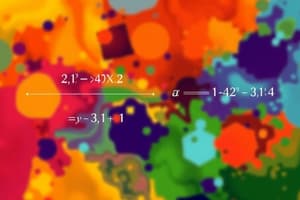Podcast
Questions and Answers
What is the primary purpose of the objective function in a linear programming problem?
What is the primary purpose of the objective function in a linear programming problem?
The objective function in a linear programming problem is the function that needs to be optimized (either maximized or minimized) given the constraints of the problem.
Explain the role of decision variables in a linear programming problem.
Explain the role of decision variables in a linear programming problem.
Decision variables are the unknown quantities in a linear programming problem that the decision maker needs to determine in order to optimize the objective function while satisfying the given constraints.
How are constraints typically represented in linear programming problems?
How are constraints typically represented in linear programming problems?
Constraints in linear programming problems are typically represented as linear inequalities or linear equations.
What is the main advantage of using the graphical method to solve a linear programming problem?
What is the main advantage of using the graphical method to solve a linear programming problem?
Explain the process of mathematically formulating a linear programming problem.
Explain the process of mathematically formulating a linear programming problem.
What is the purpose of constraints in the context of linear programming problems?
What is the purpose of constraints in the context of linear programming problems?
Describe the key steps involved in mathematically formulating a linear programming problem.
Describe the key steps involved in mathematically formulating a linear programming problem.
Express a linear programming problem in its standard mathematical form.
Express a linear programming problem in its standard mathematical form.
What is the main idea behind the graphical approach to solving linear programming problems?
What is the main idea behind the graphical approach to solving linear programming problems?
Outline the key steps involved in solving a linear programming problem graphically.
Outline the key steps involved in solving a linear programming problem graphically.
Study Notes
Numerical and Statistical Methods: Understanding Linear Programming Problems (LPP)
Linear programming is a powerful numerical and statistical method that enables decision makers to optimize outcomes within resource constraints. It is commonly used in a wide range of applications, including resource allocation, manufacturing operations, financial investments, and project management. In this article, we will delve deeper into linear programming problems (LPPs), focusing on the concepts of linear programming, mathematical formulation, and graphical methods.
Common Terminology for Linear Programming Problems (LPP)
Before diving into the details of linear programming, it's crucial to familiarize ourselves with the key terms and principles involved. Some important concepts include:
-
Objective Function: This refers to the function to be optimized, often represented as Z or f(x, y). It could be either the maximum or minimum value depending on the specific problem.
-
Variables: Variables represent the unknown quantities in a linear programming problem. They are usually denoted by lowercase letters such as x, y, or z.
-
Decision Variables: These are specific variables that need to be selected by the decision maker. They are subject to certain constraints and aim to maximize or minimize the objective function.
-
Inequalities and Equations: Constraints in linear programming problems are typically represented as linear inequalities or equations. Inequalities involve comparison operators such as '<', '>', '<=' or '>=' between variables and constant values.
-
Constraints: Constraints define the boundaries within which the decision variables must operate. They ensure that the solution is feasible and meets the necessary conditions.
-
Graphical Method: An alternative technique for solving linear programming problems, especially useful when dealing with two or three decision variables.
Mathematically Formulating LPP
To solve a linear programming problem mathematically, follow these steps:
-
Define the Objective Function: Specify the function to be optimized as Z = f(x, y).
-
Identify the Decision Variables: Determine which variables need to be chosen (x1, x2, ..., xn).
-
State the Constraints: List the constraints that define the feasible region, such as linear inequalities or equations.
-
Implement Non-Negativity Restrictions: Ensure that the decision variables are non-negative, i.e., x1 ≥ 0, x2 ≥ 0, ..., xn ≥ 0.
By combining these elements, we can formulate a linear program as follows:
Maximize Z = f(x1, x2, ..., xn) Subject to constraints: Ax ≤ b, x ≥ 0.
Graphical Approach to Solving LPP
When solving linear programming problems graphically, the main idea is to visualize the feasible region and identify the optimal solution. Key steps include:
-
Plot all the constraints in a coordinate system, ensuring they are satisfied simultaneously.
-
Identify the feasible region, which is the area enclosed by the constraints.
-
Evaluate the objective function at each vertex within the feasible region.
-
Choose the vertex with the highest (or lowest, depending on the problem) value of the objective function as the optimal solution.
This approach is particularly useful for understanding the relationship between the objective function and the constraints in linear programming problems.
In conclusion, linear programming problems play an indispensable role in optimization and decision-making processes across various fields. By mastering the mathematical formulation and graphical methods, practitioners and researchers alike can effectively tackle complex problems and derive valuable insights from their data.
Studying That Suits You
Use AI to generate personalized quizzes and flashcards to suit your learning preferences.
Description
Explore the key concepts of linear programming problems (LPP) including objective functions, decision variables, constraints, and graphical methods. Learn how to mathematically formulate LPP and solve them using the graphical approach. Enhance your understanding of linear programming for optimization and decision-making processes.



